World 6-3
I remember being confused a long time ago when someone referred to the “ice level” in Super Mario Bros.
“Super Mario Bros. doesn’t have an ice level,” I said, puzzled. Later, I realized they were referring to World 6-3, which features a monochromatic color scheme. But I never parsed it as ice, personally. This always struck me as a volcanic wasteland covered with ash, the only hint of color coming from the reflection of magma tinting the undersides of the clouds red.
Then again, it could just be that Miyamoto and co. only had so many different color schemes to work with and nothing in particular was meant with this particular design.
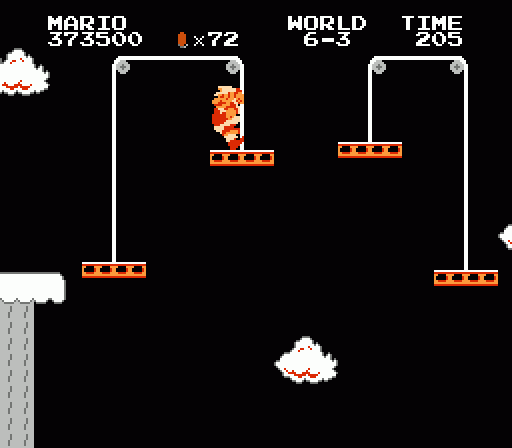
World 6-3 takes us back once again to the high columns and falling platforms of previous x-3 worlds. Things are trickier, though. Moving platforms are narrower than before, and there’s even less firm purchase to be found on what passes for solid ground. In several cases, you need to leap off springboards and onto tiny shifting platforms high above. Simply completing the stage requires good reflexes, but gathering all the coins proves to be even trickier.
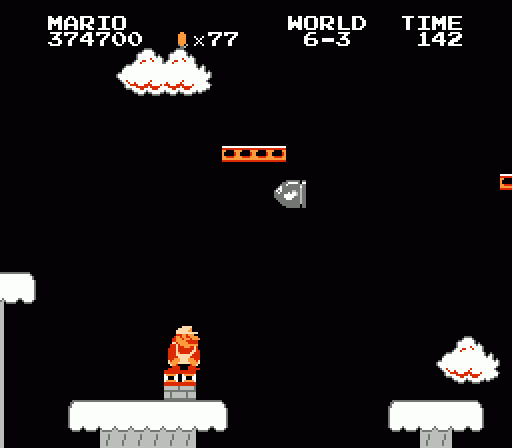
Midway through the level, Bullet Bills suddenly appear. They only harass you for a couple of screens, but their unexpected reappearance combined with the high ups-and-downs of this level make their return quite memorable. The part where you have to jump off a high platform down to a low springboard and bounce back up to the top of the screen while under fire from Bullet Bills requires calm nerves, for sure.
World 5-3’s coins that can only be collected by riding a descending platform return here with a vengeance. This time, the platforms are simply stand-alone objects that drop more rapidly than the pulley systems and consequently require faster jumping. One surprising characteristic of the level design is that the further you advance into the game, the more finesse you need to apply in order to navigate he ever-shrinking platforms. Well, that’s not a surprise, but the fact that this fine maneuvering entails relying less on the run button rather than more might be.
World 6-4
“Oh, man,” you think. “This level is a total cakewalk!”
And it is! The challenge level takes a significant step backward in World 6-4 from the cruelty of World 5-4. No super-sized fire bars. No extra fast fire bars. Only a handful of Podooboos flanking columns dotted with fire bars. No tiny elevators to navigate. And the obligatory hall of spinning fire is much wider, providing far easier clearance than before.
Then you get to Bowser.
Maybe you guessed something was up when Bowser’s flames started flying faster and more fiercely than before. Suddenly there are two on-screen at once instead of just one at a time. And they seem a little faster. And they tend to home in on Mario’s position, too.
Another tip-off: A large depression in the floor with hidden coin blocks. Why call back to World 1-4 after progressively minimizing these little safety spots for so long? What could it mean?
What is means is that Bowser has entered full-on bastard mode here. The encounter space at the end of World 6-4 is almost exactly the same as in World 5-4… but for one difference. Namely, now Bowser can chuck hammers. Yes, just like the Hammer Bros., Bowser has his own projectiles. They arc up high, forcing you to make a very well-timed leap to clear them. And you’d better hope to god he doesn’t jump when you do, because he continues tossing hammers even in mid-air.
This is it. This is the end of Super Mario Bros. even pretending to go easy on you. For the final quarter of the adventure, the gloves are off. Bowser has escalated things, and there’s no going back.
What’s a squid doing in here, anyway? Now they’re just trolling us.
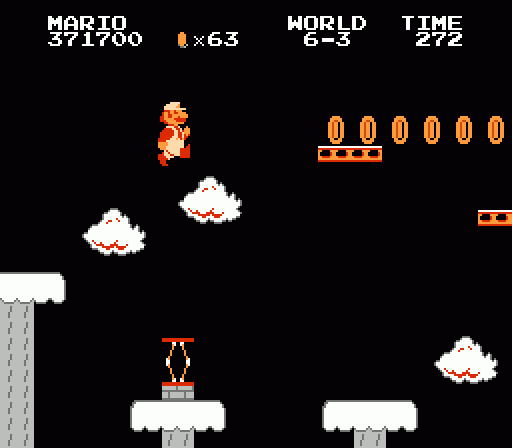
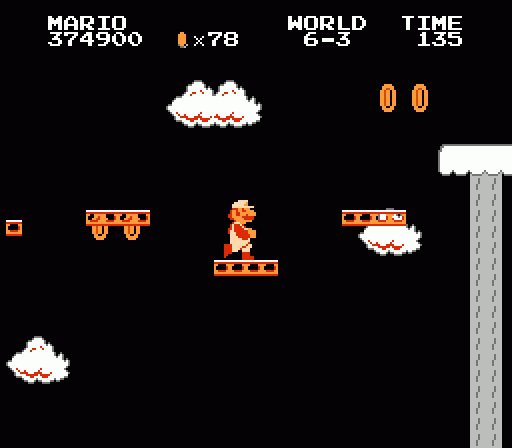
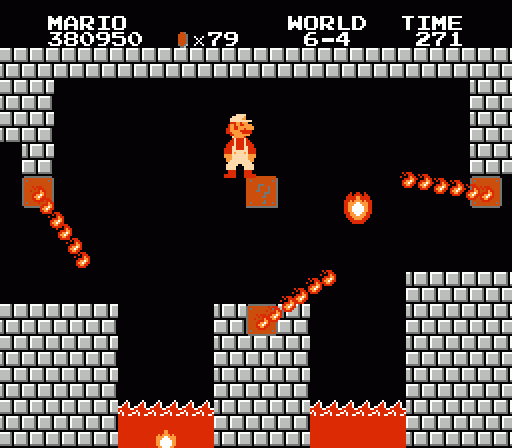
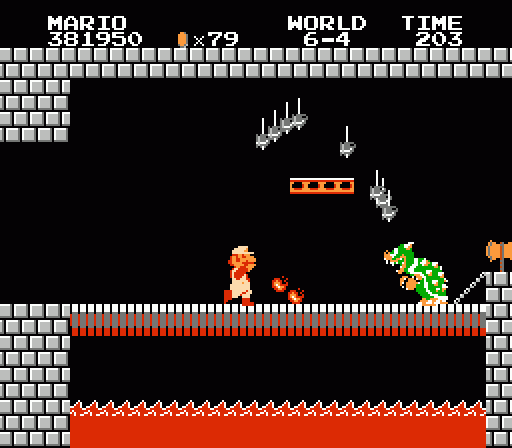
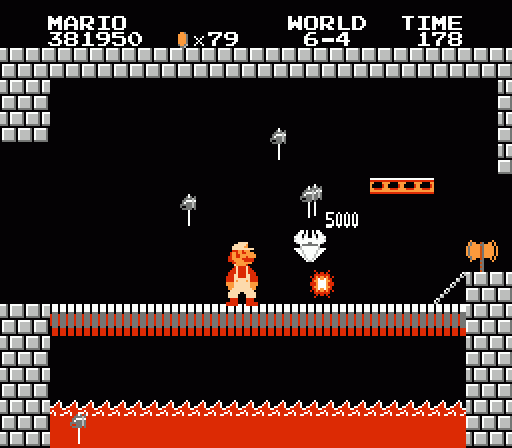
I’d say the impression of the “ice level” comes not from the grey parts, but the platforms themselves, which could be snow. And since it’s high up, which might suggest (to a child, maybe) mountains and peaks. But I agree - I never got the impression it was snow/ice, but I didn’t see it as ashen either. Just a sort of bleak grey/black scheme.
At its most basic, 6-4 is 1-4 with more fire bars, but this is also the stage where the Bowsers get more serious. Previous Bowsers relied on brick placement and Podoboos to tilt the odds in their favor, but here we see a Bowser with a more aggressive fire assault and who can throw hammers. 6-4 being a redux of 1-4 is meant to catch players off guard.
With that said though, Bowser’s still pretty easy compared to Hammer Bros. The arc he throws his waves of hammers in leaves a huge blind spot, and he still jumps high enough that it’s not too hard to run underneath him. The message the game’s been trying to send is clear: Take the low road.
For the very few times that I played that level, I never saw it as being an ice level either.
However, as time went on and I stated encountering the trope of grass/ice/fire/etc level on most platformers, I realized then that the white on the platforms meant it was an ice level.
I could be remembering this wrong, but didn’t they actually make 6-3 a full-on snow level in the Super Mario All-Stars remake? I’m pretty sure I recall it being covered in snow there…
While Hiroshi Yamauchi is on our minds, would anyone care to guess what influence he had on this game? Maybe part of why it gets hard is that he wanted players to get their money’s worth by not having it end too quickly or easily? Or maybe Bowser was inspired by Yamauchi’s habit of breathing fire and chucking hammers.
I’d venture a guess that people referring to an “ice level” may me referring to World 7, where the color scheme is white instead of green.
I always liked the theory you proposed back in your 1UP days, Jeremy, where the reddish tints in 6-3 were the first hints of sunrise in the early hours of the morning. Of course, it could just be a random mixing up of the color palette, but either way, it *does* stand out.
I said that? I don’t remember that at all.
Since there are no “slipping” mechanics on the platforms, my vote is that it’s just simply night time.
And I understand that slipping wasn’t yet a platform staple when SMB was released, but without it, I just can’t call it ice.
The ash theory is a good one, especially when pointing out the random red underbellies of the clouds. Maybe they are Lakitu eggs about to hatch? The mushroom kingdom is a pretty sophisticated eco-system after all.
I like the ash/volcano theory too, I always imagined it as a “graveyard” level, dead and bony.